This post may contain affiliate links. Please read our policy page.
If you love Italian cuisine, you can’t miss these 10 must-know dishes. Start with rich Spaghetti Carbonara and comforting Lasagna, then savor the creamy beauty of Risotto Alla Milanese. Don’t forget the iconic Margherita Pizza and tender Osso Buco. Fresh Caprese Salad and fragrant Pesto Alla Genovese make for perfect sides. For dessert, indulge in classic Tiramisu. Each dish celebrates quality ingredients and simplicity, inviting you to discover more delights from Italy’s culinary heart.
Spaghetti Carbonara
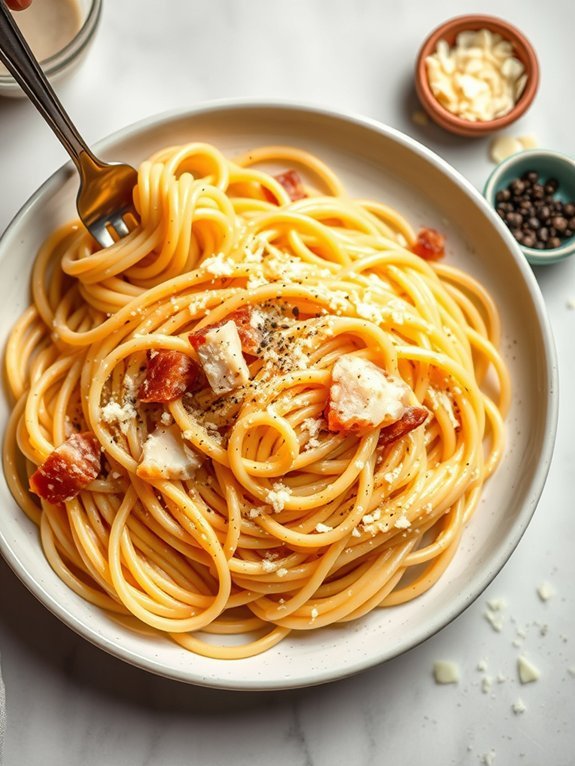
Spaghetti Carbonara is a classic Italian dish that hails from Rome, renowned for its creamy texture and rich flavors. Traditionally made without cream, the creaminess of the sauce is achieved through a combination of eggs, cheese, and the rendered fat from pork. This dish is beloved not only for its simplicity and speed but also for the decadent taste that can be created with just a few high-quality ingredients.
To make authentic Spaghetti Carbonara, one must start with quality pasta and proper technique. The secret lies in combining the hot pasta with the egg and cheese mixture off the heat to create a silky sauce that clings to each strand. This dish epitomizes comfort food, making it a perfect choice for both busy weeknights and special occasions, delivering a taste of Italy with every bite.
- 400g spaghetti
- 150g guanciale (or pancetta)
- 3 large eggs
- 100g Pecorino Romano cheese, grated
- 50g Parmigiano-Reggiano cheese, grated
- Black pepper, freshly ground
- Salt, for pasta water
Bring a large pot of salted water to a boil and cook the spaghetti until al dente. Meanwhile, in a pan over medium heat, cook the guanciale until crisp and golden. In a bowl, whisk together the eggs and both cheeses, adding a generous amount of black pepper.
Once the pasta is cooked, reserve a cup of pasta water, then drain the spaghetti. Mix the hot pasta with the guanciale and its fat, remove from heat, and then quickly stir in the egg and cheese mixture, adding reserved pasta water as needed to achieve a smooth, creamy sauce.
When making Spaghetti Carbonara, always verify that the eggs don’t scramble when mixed with the hot pasta. The residual heat from the pasta is sufficient to cook the eggs gently, creating a velvety sauce.
Also, don’t hesitate to adjust the amount of cheese and pepper to your liking, as these flavors are central to the dish. Finally, serve immediately, as Carbonara is best enjoyed fresh and hot, providing a delightful experience right from the first bite.
Lasagna
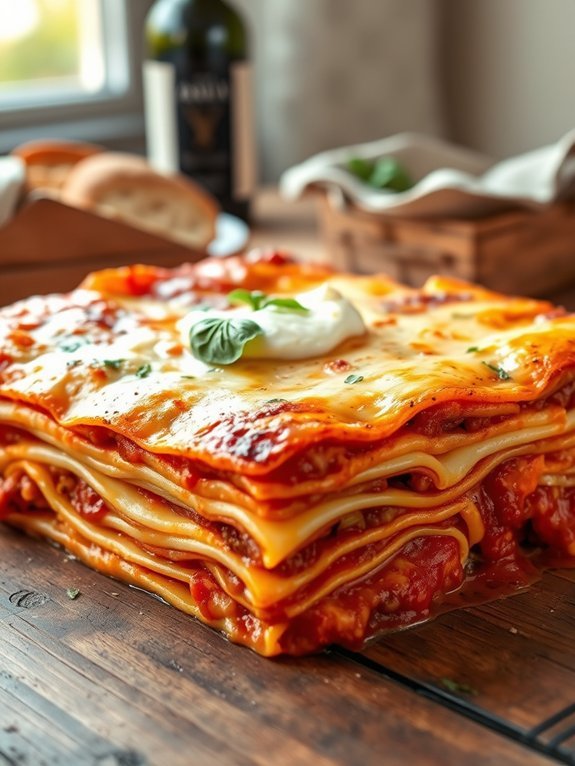
Lasagna is a beloved dish that epitomizes comfort food with its rich flavors and hearty layers. Originating from Italy, this baked pasta dish features sheets of lasagna layered with a combination of meat sauce, béchamel or ricotta cheese, and mozzarella. Perfect for family gatherings or a cozy dinner, homemade lasagna allows for endless variations while remaining rooted in tradition.
Making a classic lasagna can be a delightful experience. While the ingredients can be straightforward, the method of layering and baking is what results in a masterpiece that can impress any dinner guest. This dish isn’t only a feast for the palate but also for the eyes, with its colorful layers of pasta, vibrant tomato sauce, and melting cheese.
Ingredients:
- 12 lasagna noodles
- 1 pound ground beef
- 1 pound ground Italian sausage
- 2 cups marinara sauce
- 2 cups ricotta cheese
- 2 cups shredded mozzarella cheese
- 1 cup grated Parmesan cheese
- 1 egg
- 2 cloves garlic, minced
- 1 teaspoon dried oregano
- Salt and pepper to taste
- Fresh basil for garnish (optional)
Preheat your oven to 375°F (190°C). Cook the lasagna noodles according to package instructions, then drain and set aside.
In a large skillet, sauté the ground beef and sausage over medium heat until browned. Add the minced garlic and cook for an additional minute, then stir in the marinara sauce.
In a separate bowl, mix the ricotta cheese, egg, oregano, salt, and pepper. To assemble the lasagna, spread a thin layer of the meat sauce on the bottom of a baking dish, layer three noodles on top, followed by half of the ricotta mixture, a third of the mozzarella, and a layer of meat sauce.
Repeat the layering process, finishing with noodles topped with the remaining meat sauce and mozzarella. Bake for about 30-40 minutes until the cheese is bubbly and golden, then let it rest for 10 minutes before serving.
For the best results, consider prepping your lasagna a day ahead, refrigerating it overnight. This allows the flavors to meld beautifully and the noodles to absorb the sauce. You can also customize your meat sauce with different herbs or vegetables like spinach or mushrooms for an added twist.
If you prefer a crispier top, bake uncovered for the last 10 minutes. Remember, letting the lasagna sit after baking helps it set, making it easier to cut and serve. Enjoy your delicious homemade lasagna!
Risotto Alla Milanese
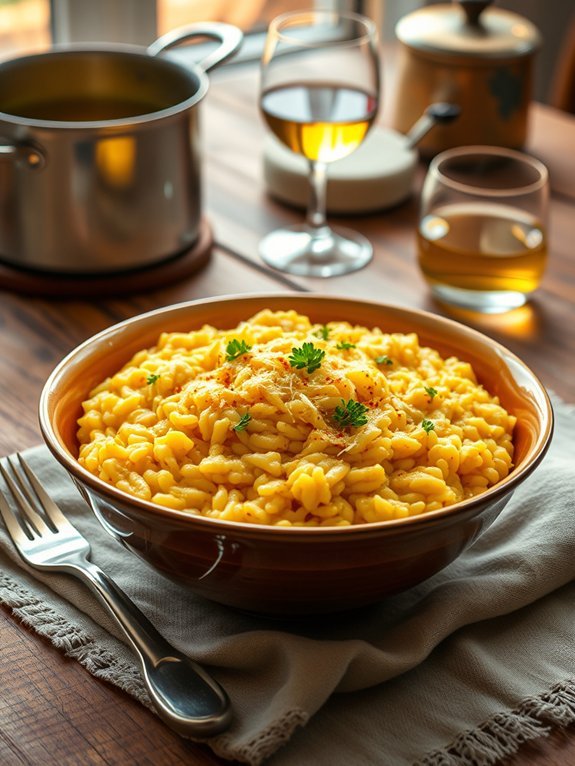
Risotto Alla Milanese is a classic Italian dish that hails from the northern city of Milan. Known for its luxurious texture and rich flavor, this risotto is easily recognizable for its vibrant golden hue, which comes from adding saffron, a prized spice famous for its distinct taste and aroma. Traditionally served as a primo or first course, risotto is a comforting dish that delights the palate with its creamy consistency and aromatic profile.
Preparing Risotto Alla Milanese requires careful attention to the choice of ingredients and the cooking process. Arborio rice is the best fit for this dish due to its high starch content, which yields the beloved creamy texture. The caramelized onions, white wine, and ladles of warm broth contribute depth of flavor, while the finishing touches of parmesan cheese and butter elevate the dish to an indulgent delight.
This dish isn’t just a meal but a symbol of Italian culinary artistry that can be enjoyed on special occasions or as a weeknight treat.
- 1 cup Arborio rice
- 4 cups chicken or vegetable broth
- 1 medium onion, finely chopped
- 1 tablespoon olive oil
- 1 tablespoon unsalted butter
- 1/4 cup dry white wine
- 1/4 teaspoon saffron threads
- 1/2 cup grated Parmesan cheese
- Salt and pepper to taste
- Fresh parsley for garnish (optional)
In a saucepan, warm your broth over low heat, and in a separate large skillet, heat the olive oil and butter on medium heat. Sauté the chopped onion until translucent and fragrant, about 5 minutes. Stir in the Arborio rice, allowing it to toast slightly before adding the white wine, stirring constantly until it evaporates.
Gradually add the warm broth one ladle at a time, stirring continuously, allowing each addition to be absorbed before adding the next. Once the rice is al dente and creamy, stir in the saffron, Parmesan cheese, salt, and pepper. Remove from heat and let it rest for a minute before serving. Garnish with fresh parsley, if desired.
When preparing Risotto Alla Milanese, patience is key; continuously stirring while gradually adding the broth not only helps achieve that desired creamy texture but also enhances the flavor. Remember, the key is to avoid rushing the process—the risotto should simmer gently.
Additionally, using high-quality broth and fresh Parmesan cheese can make a significant difference in the final outcome. Don’t be afraid to experiment with additional flavorings or garnishes that complement saffron, such as peas or crispy bacon, to make the dish your own.
Recommended Items
Discover the essential ingredients and tools to elevate your Italian cooking experience!
Margherita Pizza

Margherita pizza is a traditional Italian dish that embodies simplicity and flavor. Originating from Naples, this pizza is named after Queen Margherita of Savoy, who inspired its creation in the late 19th century. Featuring a thin crust topped with fresh tomatoes, mozzarella cheese, fresh basil, and a drizzle of olive oil, it’s a celebration of quality ingredients that come together to create a perfect harmony of taste.
The beauty of Margherita pizza lies in its minimalism, allowing each ingredient to shine while offering a delightful experience for the palate. Preparing Margherita pizza at home can be both enjoyable and satisfying. With a few crucial ingredients, you can bring a piece of Italy to your kitchen.
The key is to guarantee that your ingredients are as fresh as possible, particularly the tomatoes and mozzarella. You can choose to make your own dough or buy pre-made dough from your local grocery store. Whichever option you choose, the result will be a deliciously authentic pizza, perfect for any occasion.
Ingredients:
- 2 cups all-purpose flour
- 1 teaspoon active dry yeast
- 1 teaspoon salt
- 3/4 cup warm water
- 1 tablespoon olive oil
- 1 cup crushed San Marzano tomatoes
- 8 ounces fresh mozzarella cheese, sliced
- Fresh basil leaves
- Extra virgin olive oil, for drizzling
- Salt, to taste
To make the pizza dough, combine the flour, yeast, and salt in a mixing bowl. Gradually add the warm water and olive oil, mixing until a dough forms. Knead the dough for about 10 minutes on a floured surface until smooth and elastic.
Let it rise in a warm place for about 1-2 hours or until it has doubled in size. Preheat your oven to 475°F (245°C). Once the dough has risen, roll it out into a thin circle. Spread the crushed tomatoes over the dough, sprinkle with salt, arrange the mozzarella slices, and add the fresh basil. Drizzle some olive oil on top and bake for 10-12 minutes, or until the crust is golden brown and the cheese is bubbling.
When making Margherita pizza, it’s important to use high-quality ingredients as they greatly influence the final taste. Fresh mozzarella should be used instead of the pre-shredded type, as it melts better and has a superior flavor.
If possible, use San Marzano tomatoes for their sweetness and richness. Baking the pizza at a high temperature on a pizza stone can also enhance the crust’s crispiness. Don’t hesitate to experiment with the toppings; a sprinkle of sea salt, a splash of balsamic reduction, or a dash of chili flakes can elevate your pizza further while adhering to the classic Margherita spirit.
Osso Buco
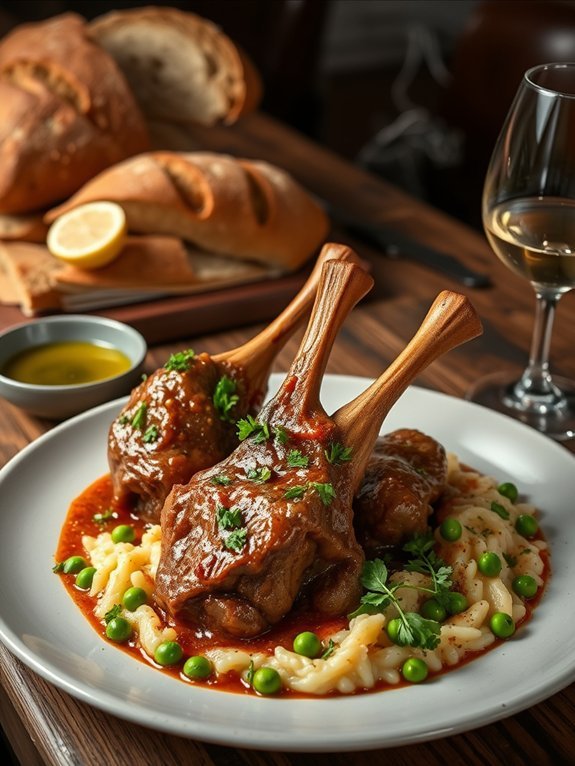
Osso Buco is a classic Italian dish originating from Lombardy, where it has been cherished for generations. The name translates to “bone with a hole,” a nod to the marrow-filled bone that’s the star of this dish. Traditionally made with veal shanks, Osso Buco is slow-cooked to perfection, allowing the meat to become tender and flavorful. It’s often served with a bright and zesty Gremolata, which consists of lemon, garlic, and parsley, enriching the dish with a fresh contrast.
This rich and hearty dish is perfect for family gatherings or special occasions, bringing the warmth of Italian cuisine to your table. Alongside the main ingredients, the gentle simmering of aromatics such as onions, carrots, and celery creates a deeply satisfying sauce that complements the robust flavors of the meat. Whether served alone or with a side of risotto or polenta, Osso Buco promises to impress your guests and tantalize your taste buds.
Ingredients:
- 4 veal shanks (about 1.5 inches thick)
- Salt and pepper, to taste
- 1/4 cup all-purpose flour
- 2 tablespoons olive oil
- 2 tablespoons unsalted butter
- 1 medium onion, chopped
- 1 medium carrot, chopped
- 1 celery stalk, chopped
- 2 cloves garlic, minced
- 1 cup dry white wine
- 1 cup beef or chicken stock
- 1 can (14 oz) diced tomatoes
- 2 teaspoons fresh thyme leaves
- 1 bay leaf
- Zest of 1 lemon
- 1/4 cup chopped fresh parsley
In a large, heavy-bottomed pot or Dutch oven, heat the olive oil and butter over medium heat. Season the veal shanks with salt and pepper, then lightly dredge them in flour, shaking off the excess. Brown the shanks on all sides in the hot oil, about 3-4 minutes per side, then remove and set aside.
In the same pot, add the onion, carrot, celery, and garlic, sautéing until softened. Pour in the white wine and scrape up any browned bits from the bottom. Return the shanks to the pot and add the stock, tomatoes, thyme, bay leaf, and simmer uncovered for about 1.5 to 2 hours, or until the meat is fork-tender.
When preparing Osso Buco, it’s important to allow ample time for slow cooking to develop the flavors and achieve that exquisite tenderness. Consider making the dish a day ahead; the flavors deepen as it sits, making it even more delicious when warmed up.
For an authentic touch, serve with Gremolata right before serving, which adds brightness and freshness, balancing the richness of the shanks. Enjoy the elegance of this Italian classic and the warmth it brings to your dining experience.
Gnocchi
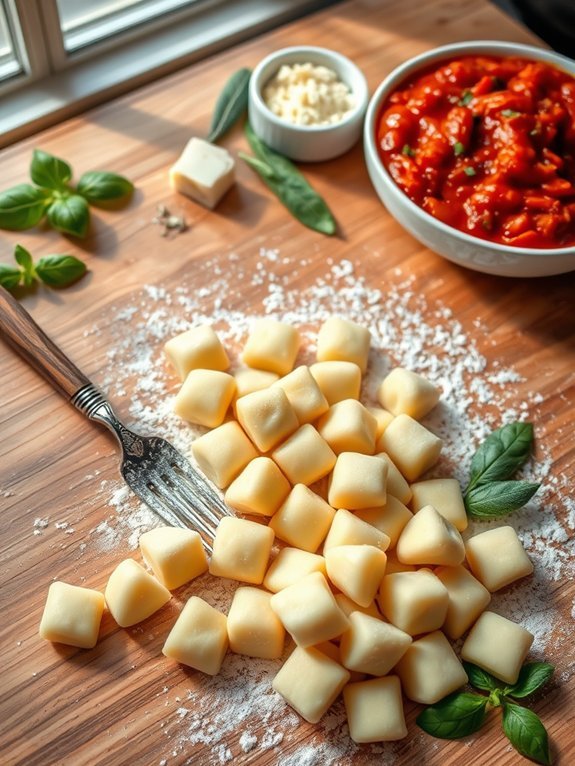
Gnocchi, the delightful Italian dumpling, is a comfort food cherished by many. Traditionally made from potato, flour, and eggs, these pillowy bites are both simple and whimsical. The beauty of gnocchi lies in its versatility; it can be enjoyed in various sauces, whether a rich marinara, a luscious sage brown butter, or even simply tossed with garlic and oil.
Making homemade gnocchi can be a rewarding culinary experience, allowing you to savor the taste of Italy in your own kitchen.
To create a perfect batch of gnocchi, the key is to use starchy potatoes, which will give your dumplings the right texture. Choose potatoes that have a somewhat dry consistency, such as russets or Yukon Golds, to guarantee that your gnocchi won’t be too dense or gummy.
Once you master the technique, you can even experiment by adding herbs or spinach for a colorful twist.
Ingredients:
- 2 pounds russet potatoes
- 1 ½ cups all-purpose flour (plus extra for dusting)
- 1 large egg
- 1 teaspoon salt
- ½ teaspoon nutmeg (optional)
- Water (for boiling)
To cook the gnocchi, first, boil the potatoes whole and unpeeled in salted water until fork-tender, about 30-40 minutes.
Once cooked, drain and let them cool slightly before peeling. In a large bowl, mash the potatoes until smooth and allow them to cool completely.
Add the flour, egg, salt, and nutmeg to the potatoes, and mix until a soft dough forms.
Roll into ropes about ½ inch thick, then cut into 1-inch pieces. Use a fork or your fingers to create indentations for that signature gnocchi shape.
Finally, boil a pot of salted water and gently drop in the gnocchi; cook until they float to the surface, which usually takes about 2-3 minutes.
When making gnocchi, guarantee your potatoes are as dry as possible for the best texture. If the dough feels sticky, use a little extra flour on your work surface, but be careful not to overwork it, as this can make your gnocchi tough.
Additionally, you can freeze the uncooked dumplings for later use; simply arrange them on a baking sheet in a single layer until firm, then transfer to a freezer bag.
Enjoy your gnocchi with your favorite sauce or sautéed veggies for a delightful meal!
Caprese Salad
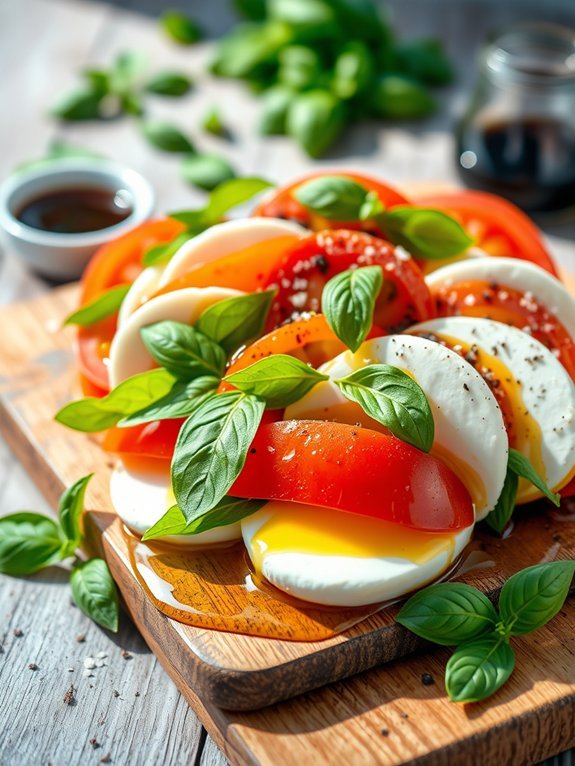
Caprese Salad is a classic Italian dish that celebrates fresh ingredients and simple flavors. Originating from the Isle of Capri, this salad is a beautiful arrangement of ripe tomatoes, creamy mozzarella cheese, and fragrant basil leaves, drizzled with high-quality olive oil and seasoned with salt and pepper.
It isn’t just a feast for the eyes but also a delightful way to enjoy the essence of Italian cuisine during the warmer months. This dish is perfect as an appetizer or side salad and can easily be tailored to suit your taste.
The key to a great Caprese salad lies in the quality of the ingredients used. Fresh, in-season tomatoes and mozzarella will elevate this dish to another level, making each bite a revitalizing experience. With its vibrant colors and enticing flavors, Caprese Salad is sure to impress guests at any gathering.
Ingredients:
- Fresh ripe tomatoes
- Fresh mozzarella cheese
- Fresh basil leaves
- Extra-virgin olive oil
- Salt
- Freshly ground black pepper
To prepare the Caprese Salad, start by slicing the ripe tomatoes and mozzarella cheese into approximately 1/4-inch thick slices. On a serving platter, alternate the tomato and mozzarella slices in a circular or straight pattern.
Tuck whole basil leaves in between the layers for an aromatic touch. Drizzle the salad with extra-virgin olive oil and sprinkle a pinch of salt and freshly ground black pepper over the top, ensuring all flavors meld together.
When making a Caprese Salad, opt for the freshest ingredients you can find, especially the tomatoes and mozzarella. Heirloom tomatoes can add a sweet, unique flavor, while buffalo mozzarella offers a rich, creamy texture that pairs beautifully with the basil.
For an added twist, consider using a balsamic glaze instead of just olive oil for a touch of sweetness and complexity. Remember to serve the salad immediately after assembling it to enjoy the prime freshness of the ingredients.
Proposed Recipe
Pesto Alla Genovese
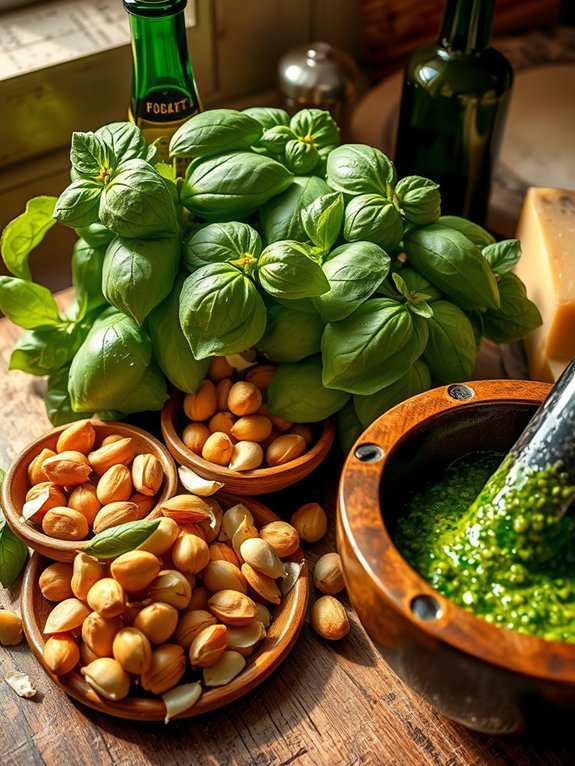
Pesto Alla Genovese is a traditional Italian sauce that hails from the beautiful region of Liguria. This vibrant green condiment is made primarily using fresh basil, garlic, pine nuts, Parmesan cheese, and olive oil, creating a rich and aromatic flavor that can elevate pastas, sandwiches, and even pizzas.
The humble origins of pesto showcase the simplicity of Italian cooking, where fresh ingredients take center stage and bold flavors shine through without the need for excessive preparation or complex techniques.
To make an authentic Pesto Alla Genovese, it’s important to use high-quality ingredients, especially the basil—look for fresh basil leaves with a vibrant green color and a fragrant aroma. Traditionally, pesto is made using a mortar and pestle, which releases essential oils from the basil and allows for a more rustic texture compared to using a food processor. However, both methods can yield delicious results, so choose whichever suits your cooking style best.
Ingredients:
- 2 cups fresh basil leaves, packed
- 1/2 cup extra virgin olive oil
- 1/3 cup pine nuts
- 2 cloves garlic, minced
- 1/2 cup grated Parmesan cheese
- Salt to taste
To prepare the Pesto Alla Genovese, start by adding the basil leaves, pine nuts, and garlic to a mortar and pestle (or a food processor). If using a mortar, gently crush the ingredients until they form a rough paste.
Gradually add the olive oil while continuing to mix until you achieve a smooth consistency. If you prefer using a food processor, pulse the basil leaves, pine nuts, and garlic until finely chopped, then slowly stream in the olive oil while blending.
Finally, mix in the grated Parmesan cheese and season with salt to taste.
When making pesto, remember that fresh ingredients are key, so use the best quality basil and olive oil you can find. To enhance the flavors, make sure to toast the pine nuts lightly before adding them to the mix, as this will bring out their nuttiness.
If your pesto appears too thick, you can always adjust the consistency by adding a touch of water or more olive oil. Store leftover pesto in an airtight container; to prolong its freshness, make sure to drizzle a thin layer of olive oil over the surface before sealing.
Tiramisu

Tiramisu is a classic Italian dessert that beautifully merges the flavors of coffee and cocoa in a creamy, indulgent treat. Originating from the Veneto region, this dessert has gained global popularity for its rich layers and delightful contrast between the softness of the mascarpone and the crispness of ladyfingers.
With its origins rooted in simple yet quality ingredients, tiramisu has become synonymous with Italian hospitality and creativity. This elegant dessert isn’t only a feast for the taste buds but also a visual delight. It’s traditionally served chilled and is perfect for special occasions or simply as a comforting treat at the end of a meal.
Making homemade tiramisu allows you to control the flavors and sweetness levels, ensuring that each bite is tailored to your palate. Best of all, it can be prepared a day in advance, making it an ideal make-ahead dessert.
Ingredients:
- 6 large egg yolks
- 3/4 cup granulated sugar
- 2/3 cup milk
- 1 1/4 cups heavy cream
- 8 ounces mascarpone cheese
- 1 cup strong brewed coffee, cooled
- 3 tablespoons coffee liqueur (optional)
- 24 ladyfingers
- Unsweetened cocoa powder, for dusting
- Dark chocolate shavings (optional, for garnish)
In a saucepan, whisk together the egg yolks and sugar over medium heat until smooth, then add the milk and cook until thickened, about 5-7 minutes, stirring constantly. Remove from heat and let cool.
In a separate bowl, whip the heavy cream until soft peaks form, then gently fold in the mascarpone cheese until well combined. Once the egg mixture is cool, mix it with the mascarpone mixture. Combine the brewed coffee with the coffee liqueur in a shallow dish.
Quickly dip each ladyfinger into the coffee mixture, then layer them in a 9×9 inch dish, followed by a layer of the mascarpone mixture. Repeat the layers until all ingredients are used, finishing with the mascarpone layer. Cover and refrigerate for at least 4 hours or preferably overnight. Before serving, dust the top with cocoa powder and add chocolate shavings if desired.
When making tiramisu, it’s crucial to use high-quality ingredients, particularly the coffee and mascarpone. This dessert’s beauty lies in its simplicity, so a good brew will elevate the flavors considerably.
Be mindful not to soak the ladyfingers too long in the coffee mixture, as they can become overly soggy. Feel free to customize the sweetness and coffee levels to suit your taste, and remember that patience is important; allowing the tiramisu to chill enhances the flavors and creates that delightful texture that makes every bite a moment of pure indulgence.
Fettuccine Alfredo
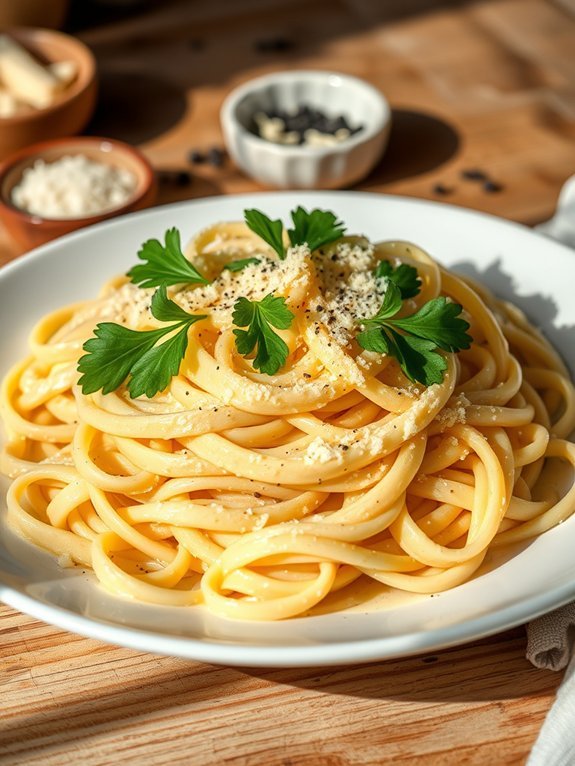
Fettuccine Alfredo is a lauded Italian dish that epitomizes comfort food with its rich, creamy texture. Originating from Rome, this dish is a simple yet delightful combination of fettuccine pasta, butter, and Parmigiano-Reggiano cheese, resulting in a velvety sauce that envelops each strand of pasta.
Traditionally, the recipe requires minimal ingredients, making it easy to prepare while still delivering an indulgent flavor that leaves a lasting impression. This dish gained widespread popularity in the United States after its introduction by Italian immigrants.
Over time, it has evolved, and variations can now include additional ingredients such as garlic, cream, or even chicken and vegetables. Nevertheless, the classic version remains a favorite among pasta lovers, embodying the essence of Italian cuisine with every bite.
Whether served as a comforting family meal or an elegant dish for entertaining, Fettuccine Alfredo is sure to satisfy any craving.
- 12 ounces fettuccine pasta
- 1/2 cup unsalted butter
- 1 cup freshly grated Parmigiano-Reggiano cheese
- Salt, to taste
- Freshly cracked black pepper, to taste
- Fresh parsley, chopped (for garnish, optional)
In a large pot of salted boiling water, cook the fettuccine pasta according to package instructions until al dente. In a separate large skillet, melt the butter over medium heat. Once the pasta is cooked, reserve about a cup of the pasta water, then drain the pasta.
Add the drained fettuccine to the skillet with melted butter. Toss the pasta until it’s well coated, then gradually sprinkle in the grated Parmigiano-Reggiano, stirring continuously. If the sauce is too thick, add some reserved pasta water, a little at a time, until you achieve the desired creamy consistency.
Season with salt and freshly cracked black pepper to taste, and serve immediately, garnished with chopped parsley if desired.
When preparing Fettuccine Alfredo, it’s crucial to use high-quality ingredients, particularly the cheese, as it’s the star component of this dish. Freshly grated Parmigiano-Reggiano will melt more smoothly and create a better texture than pre-grated varieties.
Additionally, for an even richer sauce, you can add a splash of heavy cream to the butter before mixing in the cheese. Remember to serve it immediately after preparation, as the sauce can thicken as it cools, and nothing beats the creamy, buttery flavor enjoyed fresh from the stove!









